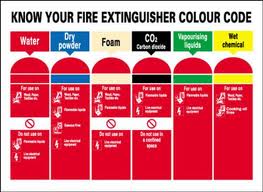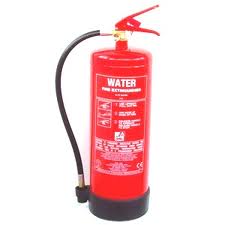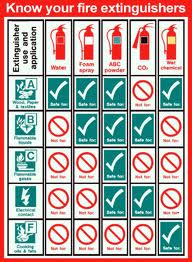No single type of extinguisher is totally effective on every kind of fire. So before buying a fire extinguisher, it is vital to look carefully at what type of fire it has to be used on. Each risk type has a letter associated with it (A, B, C, F), with the exception of electrical risk. Fire extinguishers are classified into four categories based on different types of fires. There are five types of extinguishers commonly  used in Ireland. These are;
used in Ireland. These are;
- Water
- AFFF Foam
- CO2
- ABC Powder
- Wet Chemical
Fire Extinguisher Guidance
Fire extinguishers are to be installed in accordance with I.S. 291: “The use, siting, inspection and maintenance of portable fire extinguishers.” Extinguishers shall be located in conspicuous positions on brackets or stands where they will be readily seen by persons following an escape route. The most suitable locations for siting extinguishers are near to room exits, corridors, stairways, lobbies and landings.
Fire Extinguisher Inspection
An inspection is a “quick check” to give reasonable assurance that a fire extinguisher is available, fully charged and operable. The value of an inspection lies in the frequency, regularity, and thoroughness with which it is conducted. Inspection of extinguishers shall be carried out at monthly intervals by the user, or agent appointed by the user, supplier, or a competent extinguisher maintenance agent. More  frequent inspection may be necessary in the following cases:-
frequent inspection may be necessary in the following cases:-
- High frequency of outbreaks of fires;
- Severe hazard;
- Susceptibility to tampering, damage, vandalism or malicious mischief;
- Locations which make extinguishers susceptible to mechanical injury such as exposure to abnormal temperatures, to corrosive atmospheres or to physical obstructions.
Fire Extinguishers Maintenance
Fire extinguishers should be maintained at regular intervals (at least once a year), or when specifically indicated by an inspection. Maintenance is a “thorough check” of the extinguisher and it is intended to give maximum assurance that an extinguisher will operate effectively and safely. It includes a thorough examination and any necessary repair of the fire extinguishers mechanical parts, recharging or replacement of the expellant gas. Maintenance of the extinguisher shall be carried out by a competent, trained person who is familiar with the equipment and with any special procedure recommended by the manufacturer.
Application of fire extinguisher
Before using your fire extinguisher, be sure to read the instructions before it’s too late. Although there are many different types of fire extinguishers, all of them operate in a similar manner. Use this acronym as a quick reference P.A.S.S.:
- Pull the Pin at the top of the extinguisher. The pin releases a locking mechanism and will allow you to discharge the extinguisher.
- Aim at the base of the fire, not the flames. This is important – in order to put out the fire, you must extinguish the fuel.
- Squeeze the lever slowly. This will release the extinguishing agent in the extinguisher. If the handle is released, the discharge will stop.
- Sweep from side to side. Using a sweeping motion, move the fire extinguisher back and forth until the fire is completely out. Operate the extinguisher from a safe distance, several feet away, and then move towards the fire once it starts to diminish. Be sure to read the instructions on your fire extinguisher – different fire extinguishers recommend operating them from different distances. Remember: Aim at the base of the fire, not at the flames!!!!
Tips for the safe use of any type of extinguisher:
- Make sure you read the instructions & are familiar with how to use it
- Position the extinguisher where you can get to it quickly
- Only buy one you can carry easily
- Don’t put it near a heater or fire, but do fix it to the wall, so that it is out of the reach of children, but easily accessible by others
- Get it serviced once a year (or as often as the manufacturer recommends
- When using the extinguisher on a fire, keep yourself on the escape route side of the blaze.
- Your safety should always be your primary concern, only use a fire extinguisher if the fire is small and is not spreading.
For Electrical fire always isolate the power supply first before extinguishing a fire

Fire extinguisher use and applications
